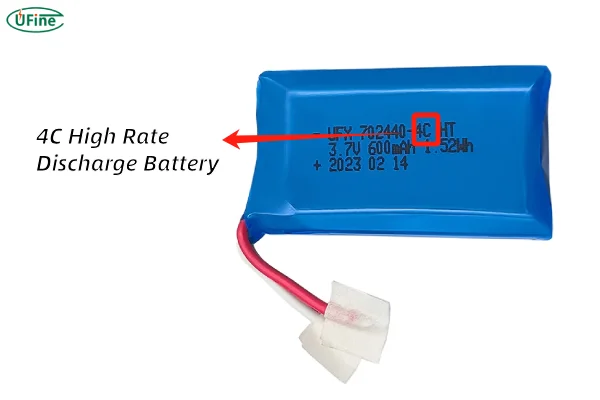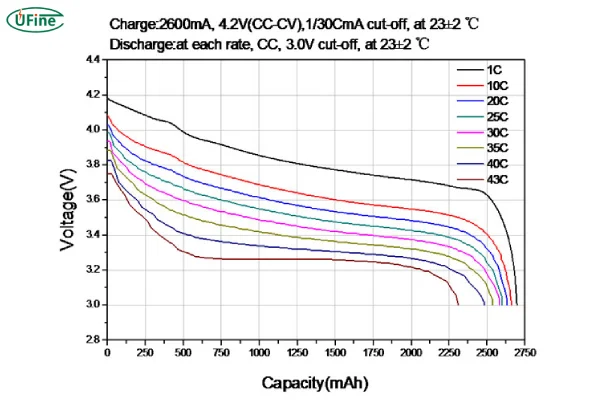When it comes to batteries, especially in high-performance applications, understanding the “C” rate is essential. But what does “4C” actually mean? If you’re new to this concept or want to understand it better, you’re in the right place. This article will walk you through everything about 4C batteries — from their meaning to their applications — and help you decide whether they’re right for your needs.
Part 1. What does 4C mean on the battery?
At the core of many battery specifications lies the “C” rate, which is often misunderstood. The “C” rate refers to the charging and discharging speed of a battery, and it’s directly related to its capacity. Simply put, the C rate tells you how fast a battery can be safely charged or discharged relative to its capacity.

For a 4C rating, it means that the battery can be discharged at a rate four times its nominal capacity in one hour. So, if you have a 1,000mAh battery, a 4C rating means it can discharge at 4,000mA (4A). This is important because it gives you a sense of how quickly the battery can deliver power, which is especially critical in high-drain devices like drones, RC cars, and power tools.
But remember, the C rating also impacts how long the battery lasts and how hot it can get. Higher C rates mean more power and faster discharges, but they can also lead to quicker wear and higher temperatures, which can affect the battery’s lifespan.
What does C Mean in Batteries?
Part 2. 4C battery types
There are several different types of 4C-rated batteries, each designed for specific purposes and offering unique features. Let’s dive into the most common types:
-
Lithium-Ion (Li-ion) 4C Battery
- Characteristics: These batteries are the most popular for consumer electronics and electric vehicles. They offer a high energy density, long lifespan, and relatively light weight.
- Best for: Smartphones, laptops, power tools, and electric bikes.
-
Lithium Polymer (LiPo) 4C Battery
- Characteristics: LiPo batteries are similar to Li-ion but are more flexible in terms of shape and size. They can handle high discharge rates like 4C, making them great for high-performance applications.
- Best for: Drones, RC cars, and other hobbyist electronics.
-
Nickel-Metal Hydride (NiMH) 4C Battery
- Characteristics: NiMH batteries are known for their environmental friendliness and moderate energy density. They can also handle high discharge rates but typically have a shorter lifespan than Li-ion or LiPo batteries.
- Best for: Power tools, flashlights, and other devices requiring frequent but less intense power bursts.
Part 3. 4C Battery voltage
When selecting a 4C battery, voltage is an important consideration. Common 4C battery voltages include:
- 3.7V: Common for Li-ion and LiPo batteries. This voltage is typically used in consumer electronics, such as smartphones and portable devices.
- 7.4V: Often found in two-cell batteries, especially in high-drain applications like RC cars or drones.
- 12V: More common in power tools, flashlights, and some electric vehicles.
The voltage determines how much power the battery can deliver. Higher voltage batteries are capable of powering larger devices and can handle higher power draws.
Part 4. Advantages and disadvantages
Like any technology, 4C-rated batteries come with their pros and cons. Here’s a breakdown:
Advantages:
- High Discharge Rate: The primary advantage of 4C batteries is their ability to provide high current output. This makes them ideal for high-drain applications that require quick bursts of power.
- Compact Size: Despite their power, many 4C batteries, especially LiPo, are lightweight and compact, making them ideal for portable devices like drones.
- Longer Runtime for High-Drain Devices: Devices such as RC vehicles, drones, and power tools often run longer on a 4C battery because it can provide quick bursts of energy without overloading.
Disadvantages:
- Potential for Overheating: Due to the higher discharge rates, these batteries can get hot quickly, especially if they’re pushed beyond their limits. This can lead to thermal issues and reduced lifespan.
- Shorter Lifespan: Batteries with higher C ratings tend to degrade faster than their lower-rated counterparts, especially when used continuously at high discharge rates.
- Cost: 4C batteries, particularly high-quality ones like LiPo and Li-ion, can be more expensive than lower-rated batteries, making them less accessible for casual users.
Part 5. 4C battery applications
Thanks to their high discharge rates, 4C batteries are used in various fields where powerful bursts of energy are needed quickly and efficiently. Here are some of the most common applications:
- Drones: Drones require rapid bursts of energy for takeoff and sustained flight, making 4C batteries (especially LiPo) a perfect match.
- RC Vehicles: Whether it’s a remote-controlled car, boat, or plane, RC vehicles need batteries that can discharge rapidly to deliver quick speeds and maneuverability.
- Power Tools: High-drain power tools, like drills and saws, benefit from the energy delivery of 4C batteries, ensuring smooth performance during intense tasks.
- Electric Vehicles: While not as common as Li-ion batteries, 4C-rated cells are sometimes used in electric bikes and scooters for added power and performance.
Part 6. How long do 4C batteries last?
The lifespan of a 4C battery depends on various factors, including how often it’s used and how well it’s maintained. Generally, these batteries last between 300 to 500 charge cycles before they begin to lose capacity. However, if you constantly push the battery to its limits, you may see a reduction in lifespan.
It’s also worth noting that different battery chemistries have different longevity profiles. For example, Li-ion batteries tend to last longer than NiMH batteries, making them a better choice for long-term use.
Part 7. Charging and chargers
Charging 4C batteries requires the right type of charger, as using an incorrect charger can damage the battery and reduce its lifespan. Here are a few tips:
- Use a Charger with the Correct Voltage: Always match the charger to the battery voltage. For example, a 3.7V battery needs a 3.7V charger, and a 7.4V battery needs a 7.4V charger.
- Avoid Overcharging: Overcharging can lead to overheating and reduce the lifespan of your battery. Always monitor your charging process and never exceed the recommended charge time.
- Consider Smart Chargers: Smart chargers can help manage the charging process by automatically stopping when the battery is full, preventing overcharging and prolonging battery life.
Part 8. Differences between 4C batteries and other batteries
Compared to other batteries with lower C ratings, 4C batteries stand out in their ability to handle high currents without significant voltage drops. However, this high power comes at a cost — typically in size, weight, and price.
For example, a 2C battery might be sufficient for less demanding tasks like powering small electronics, while a 5C battery may be overkill for everyday uses but great for high-speed racing drones.
The key difference lies in the speed of energy delivery. A 4C battery is perfect for applications requiring instant bursts of power, while lower C batteries provide steadier, slower releases of energy over time.
Part 9. Is a larger C rating always better?
You might think that a larger C rating is always better, but that’s not necessarily the case. While a higher C rating means more power and faster discharge rates, it can also lead to several trade-offs. As we mentioned earlier, batteries with high C ratings tend to overheat faster and may degrade quicker, especially if constantly used at their maximum discharge rate.
It’s essential to match the C rating of your battery to the needs of your device. If your device requires high power and quick bursts (like a drone), then a 4C battery is ideal. But for everyday gadgets, a lower C rating might be more than enough, offering better longevity and less wear on the battery.
Part 10. Ufine Battery high-rate battery
If you’re in the market for high-rate batteries, Ufine Battery offers a wide range of solutions. Known for our expertise in lithium battery technology, Ufine manufactures high-rate batteries for various applications. Our batteries come in multiple sizes, voltages, and capacities, and can be customized to meet your specific needs.
Related Tags:
More Articles

How to Choose the Best Floor Scrubber Battery for Commercial Cleaning?
Selecting the ideal floor scrubber battery ensures a long runtime, rapid charging, and minimal maintenance for efficient commercial cleaning operations.
Battery for Blower vs Battery for Leaf Vacuum: Which One Should You Choose?
Battery for blower vs leaf vacuum—learn the key differences in power, fit, and runtime to choose the right battery for your outdoor tool needs.
How to Choose the Right Battery for Blower?
Choosing the right blower battery? Consider voltage, capacity, chemistry & usage. This guide helps match the best battery for peak performance.
How to Choose the Best Insulated Battery Box for Lithium Batteries?
Choosing the Best Insulated Battery Box for Lithium Batteries? Discover key factors such as size, material, and safety for optimal protection and performance.
7 Critical Elements on a Lithium Battery Shipping Label
What must be on a lithium battery shipping label? Learn 7 key elements to ensure safety, legal compliance, and correct handling across all transport modes.





